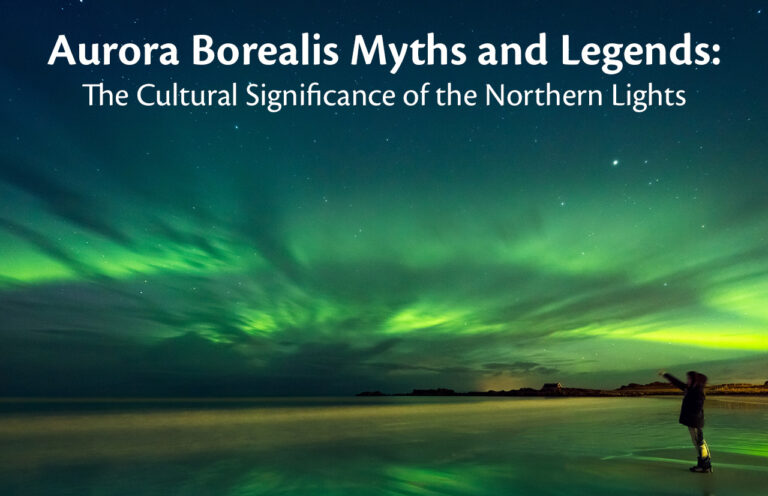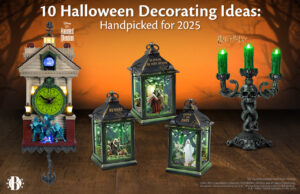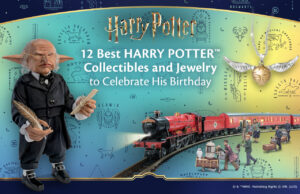The Aurora Borealis, commonly known as the Northern Lights, is a mesmerizing natural phenomenon that has enthralled humanity for centuries, inspiring a rich tapestry of myths and legends across various cultures. This natural light display is predominantly seen in high-latitude regions around the Arctic, but on rare occasions, like during solar storms, has been seen as far south as Honolulu, HI (1859), which is only 21° north of the equator, and in 1982 in Boulder, CO 40° north of the equator. The best time of year to witness them is from September to April, with the strongest possibilities during October, November and April.
(Lights also appear at the south pole, the Aurora Australis, but as few people live near enough to see them, they have not become as significant culturally.)
Table of Contents
What is the Aurora Borealis?
The terms “Northern Lights” and “Aurora Borealis” refer to the same atmospheric phenomenon. Scientifically, the Aurora Borealis occurs when charged particles emitted by the sun, primarily during solar storms, interact with Earth’s magnetic field. These particles are funneled towards the polar regions, where they collide with gases in the Earth’s atmosphere, such as oxygen and nitrogen. These collisions release energy in the form of light, creating the vibrant colored displays observed in the night sky. The specific colors—greens, reds, blues, and purples—depend on the type of gas involved and the altitude at which the interactions occur. This play of colors and light has inspired many artists, including those at The Bradford Exchange to create shimmering jeweled tributes to try to capture their allure. You can find our Aurora Borealis Jewelry on our website.
The Aurora Borealis is typically visible in regions within the high-latitude “Auroral Oval,” including parts of Scandinavia, Canada, Alaska, and Russia. The patterns and movements of the aurora are influenced by the Earth’s magnetic field, resulting in dynamic displays that can appear as arcs, curtains, or spirals of light dancing across the sky. This fleeting natural phenomenon has inspired incredible myths and legends across the regions where it is known, as each human culture strove to explain the phenomenon before science defined it.
Cultural Significance Across Different Regions
Throughout history, the Northern Lights have held profound cultural significance for various northern societies, each interpreting the phenomenon through the lens of their unique cultures, origin stories and religions:
Scandinavia: In Finnish folklore, the aurora is attributed to the “fire fox” (revontulet), a mythical creature whose fur is believed to emit sparks that light up the sky as it dashes through the snow. In Swedish culture, the Northern Lights, also called “Norrsken” in Swedish, are often seen as a sign of good fortune, particularly for fishermen who believed the lights were reflections of large schools of herring, signifying a plentiful catch; this association led to viewing the aurora as a positive omen for prosperity and a good harvest, with sightings bringing joy and hope to communities along the coast. The indigenous Sámi people of northern Scandinavia (Norway, Sweden, Finland and Russia) held a more spiritual view, often believing the lights to be the spirits of ancestors, requiring respectful behavior when viewing them. During the Viking Era, the Borealis was thought to be the Valkyries riding through the sky on errands for Odin or the aftermath of some heavenly battle. It was also associated with Bifröst, the bridge, connecting Earth to the divine realms, symbolizing a pathway between mortal and godly worlds.
Alaska and Canada’s Indigenous Tribes: Many Inuit communities perceive the Northern Lights as the spirits of animals or ancestors playing games in the sky, symbolizing a connection between the earthly and spiritual realms.
Japan: In northern Japan it’s believed that conceiving a child under the Northern Lights can bring good fortune and a blessed child, intertwining the aurora with themes of fertility and prosperity.
Russia: Russians believed the northern lights were a massive fire dragon that would descend to earth to seduce women while men were away.
Greenland and Iceland: In Greenlandic lore, the Northern Lights are believed to be the spirits of children who died at birth, dancing across the sky. In Iceland, some legends suggest the aurora can ease the pain of childbirth, though pregnant women were cautioned not to look directly at the lights to avoid complications.
Native North America: The Fox Native Americans of Wisconsin believe the lights are their slain enemies preparing for revenge.
The Algonquin people believe the lights are the reflection of a fire lit by the Creator to show he is thinking of them.
The Menominee believe the lights are torches held by giant fishermen in the night.
Modern Interpretations and Beliefs
In contemporary times, while science has demystified the aurora’s origins, the Northern Lights continue to inspire awe and are celebrated in various ways:
- Festivals and Tourism: Regions prone to auroral displays have embraced the phenomenon, hosting festivals and offering guided tours, allowing people worldwide to experience the magic firsthand. Norway, in particular, has embraced Northern Lights tourism with many hotels offering winter viewing. There are tour packages in Alaska, all of Scandinavia, Iceland, Canada and other northern locales. Some feature Northern Lights apparel, like the tributes to this incredible phenomenon found on The Bradford Exchange website. Other springtime festivals take off after the peak of Northern Lights tourism is complete, including Spring Equinox celebrations.
- Art and Media: The aurora features prominently in visual arts, literature, and films, symbolizing mystery, beauty, and the sublime. From interpretations in visual art by many artists to the novels of Jack London, to Disney’s Frozen, they appear again and again in ways large anand small. At The Bradford Exchange, we are proud to bring artists’’ work celebrating the Aurora Borealis to our customers with innovative Northern Lights home décor featuring the work of many contemporary artists and sculptors.
- Enduring Beliefs: Some traditional beliefs persist, with individuals in certain cultures still viewing the aurora as omens or spiritual manifestations, blending ancient myths with modern understanding.
Noctourism and the Northern Lights
“Noctourism,” or nocturnal tourism, is an emerging travel trend gaining momentum as travelers seek unique nighttime experiences. This trend encompasses activities such as stargazing, witnessing the Northern Lights, and participating in cultural events that occur after dark. According to Booking.com, 62% of travelers are interested in visiting “darker sky destinations” to engage in these nocturnal activities.
This surge is attributed to the allure of natural nighttime phenomena and the expansion of flight routes to such locations. Dark Sky Parks have sprung up all over the world in destinations still not suffering from light pollution.
Environmental considerations also play a role in this trend, as travelers aim to reduce light pollution and avoid daytime heat, making noctourism both an appealing and eco-conscious choice.
Dark Sky Parks and locations in the U.S. where you might see the Northern Lights include:
Fairbanks, Alaska
Headlands International Dark Sky Park Located in northern Michigan on the Straits of Mackinac and Isle Royale National Park and Preserve in Lake Michigan near the Canadian border Headlands International Dark Sky Park near Mackinaw City.
Voyageurs National Park Located in Minnesota.
Theodore Roosevelt National Park Located in North Dakota
Acadia National Park Located in Maine
Antelope Island State Park and East Canyon State Parks in Utah near Salt Lake City.
Cherry Springs State Park, Located in central Pennsylvania near the New York border.
Glacier National Park, in Montana.
Accessible Aurora Borealis viewing areas outside of the U.S.
Iceland With minimal light pollution, you can spot the northern lights just about everywhere in Iceland.
Shetland Islands, Scotland Located only 400 miles south of the Arctic Circle, this archipelago is one of the best places to see the northern lights in the world.
Norway especially areas like Tromsø and Svalbard.
Sweden Kiruna and Aurora Sky Station.
Finland Kakslauttanen Arctic Resort.

Aurora Borealis and Environmental Significance
Beyond cultural interpretations, the Aurora Borealis holds scientific importance:
- Solar Activity Monitoring: Observing auroral activity helps scientists study solar wind patterns and geomagnetic storms, providing insights into space weather phenomena.
- Impact of Climate Change: While climate change primarily affects atmospheric conditions, its influence on geomagnetic activity and auroral visibility is an area of ongoing research, with potential implications for future aurora observations.
- If you are interested in other environmental research related to northern regions: We have an informative piece about the impact of the return of wolves to Yellowstone that might be of interest at our blog.
The Aurora Borealis stands as a testament to the intricate interplay between Earth’s natural forces and human imagination. Its luminous displays have inspired a rich tapestry of myths and legends, each adding depth to our understanding of this celestial wonder. As we continue to study and celebrate the Northern Lights, they remain a bridge connecting nature, history, and the boundless realms of human creativity.
If you’d like to learn more about similar celebrations, please see our blog post on 9 Fascinating Spring Equinox Celebrations Around the World.
Would you travel to view the Northern Lights for yourself? Have you seen them? If so, we’d love to hear about it in the comments. Thanks for reading! Please like and share this post.
Aurora Borealis Myths and Legends: The Cultural Significance of the Northern Lights by The Bradford Exchange












